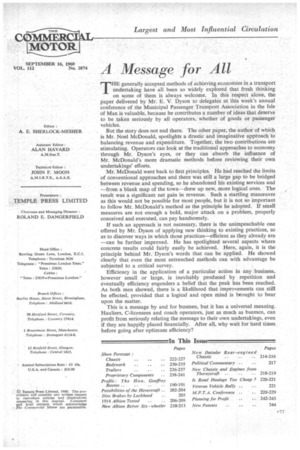A Message for All
Page 73

If you've noticed an error in this article please click here to report it so we can fix it.
THE generally accepted methods of achieving economies in a transport undertaking have all been so widely explored that fresh thinking on some of them is always welcome. In this respect alone, the paper delivered by Mr. E. V. Dyson to delegates at this week's annual conference of the Municipal Passenger Transport Association in the Isle of Man is valuable, because he contributes a number of ideas that deserve to be taken seriously by all operators, whether of goods or passenger vehicles.
But the story does not end there. The other paper, the author of which is Mr. Noel McDonald, spotlights a drastic and imaginative approach to balancing revenue and expenditure. Together, the two contributions are stimulating. Operators can look at the traditional approaches to economy through Mr. Dyson's eyes, or they can absorb the influence of Mr. McDonald's more dramatic methods before reviewing their own undertakings' efforts.
Mr. McDonald went back to first principles. He had reached the limits of conventional approaches and there was still a large gap to be bridged between revenue and spending, so he abandoned his existing services and —from a blank map of the town—drew up new, more logical ones. The result was a significant net gain in revenue. Such a startling mancetivre as this would not be possible for most people, but it is not so important to follow Mr. McDonald's method as the principle he adopted. If small measures are not enough a bold, major attack on a problem, properly conceived and executed, can pay handsomely.
If such an approach is not necessary, there is the unimpeachable one offered by Mr. Dyson of applying new thinking to existing practices, so as to discover ways in which those practices—efficient as they already are —can be further improved. He has spotlighted several aspects where concrete results could fairly easily be achieved. Here, again, it is the principle behind Mr. Dyson's words that can be applied. He showed clearly that even the most entrenched methods can with advantage be subjected to a critical survey.
Efficiency in the application of a particular action in any business, however small or large, is inevitably produced by repetition and eventually efficiency engenders a belief that the peak has been reached. As both men showed, there is a likelihood that improvements can still be effected, provided that a logical and open mind is bcought to bear upon the matter.
This is a message by and for busmen, but it has a universal meaning. Hauliers, C-licensees and coach operators, just as much as busmen, can profit from seriously relating the message to their own undertakings, even if they are happily placed financially. After all, why wait for hard times before going after optimum efficiency?




































































































































































































































